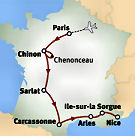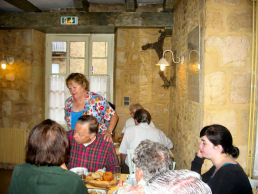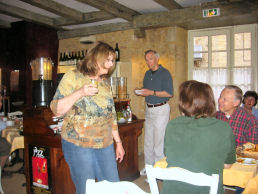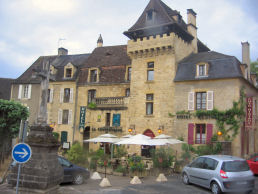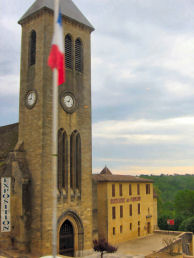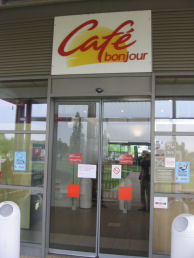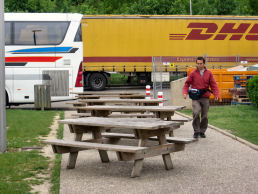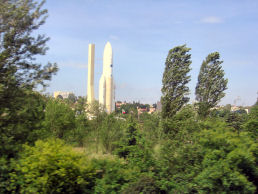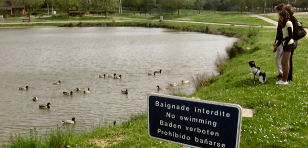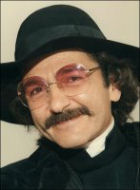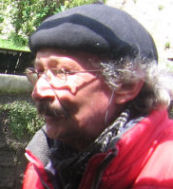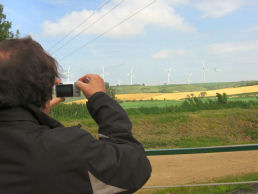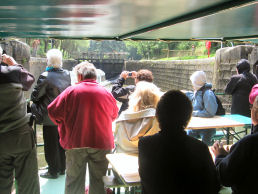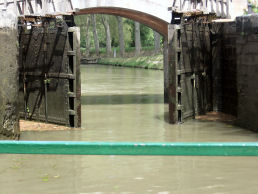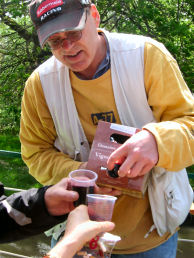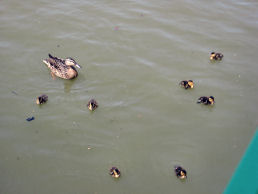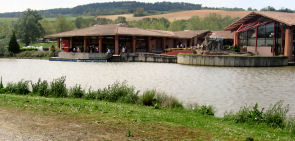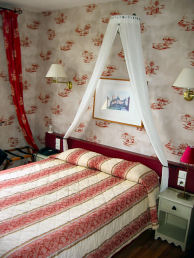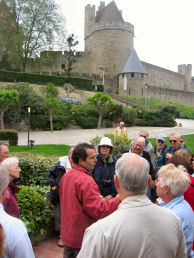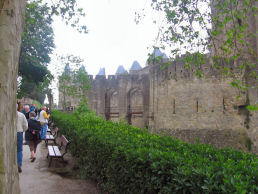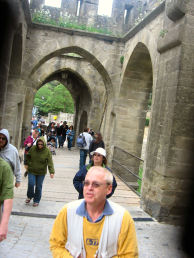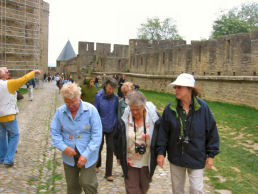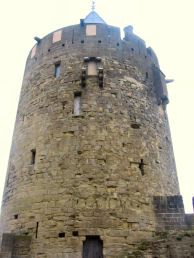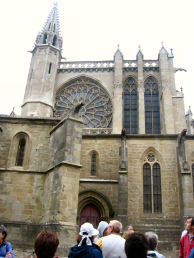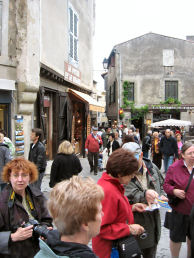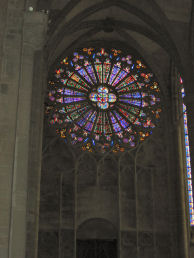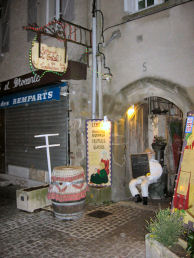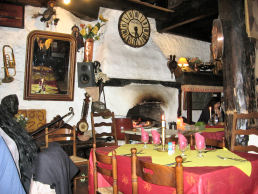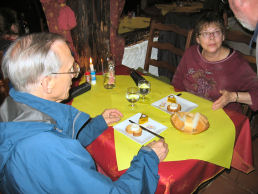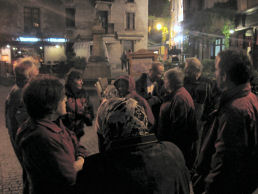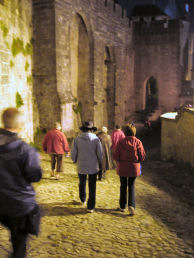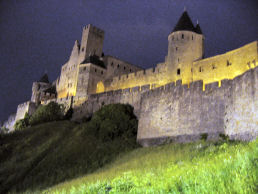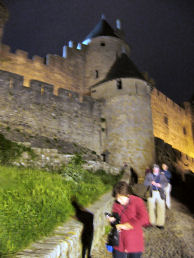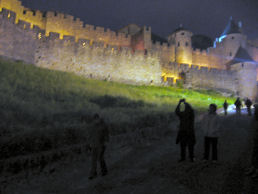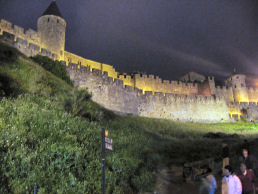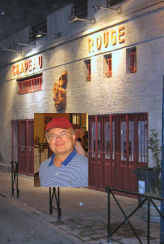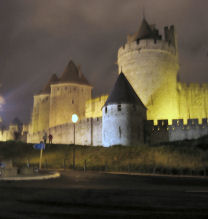Six in the morning found me feeling fit as the proverbial fiddle. I had not even suffered from cramps during the night. I could hear it raining lightly outside.
In order to connect to the wireless network, I had to hold the computer halfway out the window. I checked out the weather on the Internet. The forecast was for light rain in the morning but clearing in the afternoon. I found the score of the previous evening’s Pittsburgh-Washington NHL game, but not the Vancouver-Chicago score. It never occurred to me that the game was just getting started. There was, after all, a nine-hour time difference between France and the West Coast.There were no new e-mails that demanded immediate attention.
It upset me a little that I could not locate my water bottle. It was actually out in plain sight on the table, but I mistook it for Sue’s. At least I had not lost my mind (or my bottle).Breakfast must have been a disappointment for some. I got enough food and drink to sustain me, but they ran out of both coffee and orange juice. Perhaps the staff was not ready for so many people to come so early. I had to rate La Couleuvrine as the worst of the hotels thus far. The breakfast room was uncomfortably cramped. The dinner the first night was fine, but I did not enjoy the second night’s offering at all. Our room was so small that you had to go out into the hall to change your mind. The Internet connection on our phone did not seem to work.[1]
I stopped by the hotel desk and paid the lady there for the wine that we had consumed at dinner and the telephone call that Sue had made.Donna seemed to be feeling all right. Tom Liddle, on the other hand, said that he was still a little under the weather. He was dressed like a lumberjack at breakfast, but he donned his Unabomber outfit for the bus trip.
We all packed up and boarded the bus for Carcassonne. Sue’s backpacks and my suitcase had spawned a small grey duffle bag. I was surprised to discover that the bus’s route took us through Carsac. I even caught a glimpse of La Grange, the restaurant in which Tom, Gigi, and I had enjoyed lunch the previous day.Patrick asked us to declare what we wanted to eat at our final supper on Friday in Nice. I selected the starter of scallops, cod with pesto, and crème brûlée. I thought that it might be nice to save crème brûlée for the last meal of the tour.
Patrick informed us that most trucks were not allowed on French highways on Sunday. We did see a few, so they must have allowed exceptions.After an hour or two we stopped at a rest area named Café Bonjour that had quite a bit of clothing for sale. It even had a rather large selection of shoes. I found a polo shirt in my size that was not too flamboyant for only 10€. I almost bought it, but my penny-pinching nature got the better of me at the last minute. I went outside and then chased Tom Stan over to one edge of the rest area. We both wanted to get photos of a pigeon house there. I found the best angle, but I graciously let him borrow it. On the way back to the bus he told me that he worked as an anesthesiologist. He originally came from New Jersey.
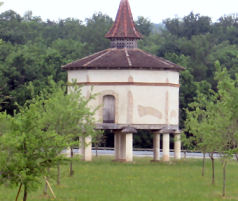
Tom Corcoran looked up the hockey scores on the Internet. Uh, oh. Vancouver lost a heartbreaker to Chicago. There would be no joy in Mudville.
The area of France near the Pyrenees has long been known as Languedoc, a reference to the Occitan language that was spoken here until late Medieval times. Northern France was once called Languedoil. The distinction was in how they said the word for yes. French became the official language in the 1500’s in the time of King Francis I. Spelling was standardized right after the French revolution.
Patrick said the area between the Massiff Centrale and the Pyrenees is sometimes also called the Tramontane. I had never heard of the Massiff Centrale, although I had deduced its existence from the flow of the rivers.We learned that Phylloxera had wiped out almost all the vineyards in this area in the early twentieth century.[2] Prior to that time the area dominated the “table wine” market. Lots of fruit crops were still grown in the area, including kiwi, peaches, and tomatoes.
The most famous local dish was cassoulet, a stew that contained duck, pork, and white beans. The traditional recipe called for it to be cooked for three days. Patrick claimed that some of the natives were so fanatical about this that if the wind changed direction while the stew pot was on the fire, they would start over. Nearly everyone seemed eager to try it.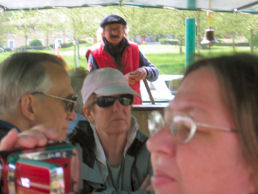
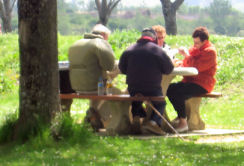
I overheard someone say that this was the best ham sandwich that they had ever eaten. They must be Jewish.
I sat at the front of the boat between Phoebe and Diane. Jacqueline, Barbara Foley, and Nancy were across from us. The wind blew Barbara’s napkin away, then the cellophane wrapper for her sandwich, and finally the lettuce from inside the sandwich. The talk at our table somehow turned to sushi. Sushi has never been big in my home state of Kansas, where the very few aquatic creatures are by and large unappetizing bottom-feeders residing in slow-moving rivers.I decided to share my joke about the origination of sushi, but only Phoebe laughed at it. I may have actually offended one or two people.
There was enough wine for everyone to get at least one cup, but Tom Stan had brought aboard a box of wine with a very large bladder inside. He generously offered some to everyone, and he made sure that the strawberries in Phoebe’s cup were always covered with wine.Sue remarked to me that the captain looked a lot like Fr. Guido Sarducci. He did, but he wore a beret rather than a capello romano.
Someone noted that it was Mother’s Day in the States. I did not hear whether it was also celebrated in France. One mother duck at Port Lauragais certainly deserved no cards. She let her entire brood swim in our boat’s slip, and Captain Sarducci did not pay them the slightest bit of attention as he steered the craft up beside the dock. We disembarked and then were allotted a few minutes to wander around the buildings of the port before the bus left for Carcassonne. Tom Corcoran, Gigi, Roscoe, and I explored an abandoned building with a field around it. We found nothing of much interest. Patrick informed us on the bus that the toll for entering Carcassonne was at one time two buckets of water. The new town, in which the entire citizenry was living in the twenty-first century, was built in the fourteenth century after it had been destroyed in the Hundred Years War. The outer walls were built in the thirteenth century (although I wrote down that Patrick said that it was in the 1300’s.) They were redone by the same guy[6] who worked on Notre Dame in Paris. By 700 the area had been conquered by the Saracens. Later it was held by the lords of Toulouse, Barcelona, and others. The early thirteenth century was a complete disaster for the Languedoc. Pope Innocent III declared a crusade against the area. Forces from the north of France poured into the area to gain the papal indulgence.In 1210 Simon de Montfort and the crusaders besieged the castle at Carcassonne. According to the local legend, Raymond-Roger le Trencavel, who was only twenty-four years old at the time, heroically gave himself up as a prisoner in order to break the siege.[7]
The place had fifty-two towers, and the old city had twenty-two wells. To me it seemed almost inconceivable that it could have submitted to a siege of less than several months, but it capitulated to Simon de Montfort with little or no struggle.An older legend held that the city derived its name from Madame Carcas, who, during Charlemagne’s siege of the city, supposedly used the last bit of grain to feed the fattest pig. She then told the men to throw the pig over the walls. The Franks were so discouraged by the fact that the residents could afford to discard such a prize that they called off the siege. There were other plausible explanations for the city’s name.
At one time a village sprung up outside of the walls of the city. We arrived at our hotel, which was just outside of the old town’s massive walls. We checked into room #34 of the two-star hotel, the Montmorency, which was affiliated with the three-star Hôtel du Château, for our one-night stand. The two hotels are in separate buildings, but they share the same management and many facilities. There was even a heated swimming pool and a Jacuzzi. Patti and Tom were assigned room #31.Patrick led the group on a walking tour of the old city. Sue tried to join us, but she had to turn back because her knee was hurting. After showing us around the city, Patrick advised us to get supper on our own and said that he would meet us at 9:30 p.m. for a stroll.
By daylight the old town was little more than a huge tourist trap. Its museum of torture and haunted house were reminiscent of a carnival. Plastic swords, maces, and battle axes could be purchased at any number of places. I found a serious book about the Albigensian Crusade called Massacre at Montségur by Zoé Oldenbourg. I could hardly believe my good fortune, and I purchased it forthwith.Tom and Patti and I walked around in search of a desirable place to eat supper a few hours later. We found one tucked away in an obscure corner of the old town. It was called Le Marchier, or something like that.
I went into the basilica, which had served as the cathedral for the diocese up until 1801. It could not have contrasted more with the rest of the old town. I found it remarkably reminiscent of the one in Sarlat. I took some photos, but the camera setting was wrong, and most of them came out badly.
St. Dominic himself visited the church in 1213 when the Albigensian Crusade was in full force. In 1898 Pope Leo XIII declared it a minor basilica. I saw plaques in the church commemorating both events.
I went back to the room after I got the code for the Internet. I washed out my brown shirt, wrung it in a towel, used the hair dryer on it, and hung it up to dry.
When I took a shower, water covered the bathroom floor and soaked one leg of my corduroy trousers. I had already used one towel to dry myself and one for my shirt. I needed to save the remaining towels for Sue. So, I just wrung out my pants as well as I could and hung them in the window to dry. What a mess. I could blame it on the fact that the door of the shower only covered half of the length of the tub, but I certainly should have noticed the problem before the pond became a lake. Sue had made reservations at 7 p.m. at L'Ostal des Troubadours. Patti and Tom agreed to try it on Sue’s recommendation, which was based on the fact that they claimed to have the best homemade cassoulet in town, and they also featured musical entertainment. Sue has always loved live musical performances of almost every sort. The restaurant turned out to be a pretty nice place, if a little crowded. It had a small fireplace and a mysterious cage, the function of which we never determined. A guy played guitar and sang songs, including “My Way,” in Spanish. Everyone but Patti ordered cassoulet. Sue had the Trencavel variety, complete with a duck leg. Tom, who also had a salad, and I had the Cathare variety, which contained a smaller unidentified duck limb. All three had sausage, pieces of pork, and lots of beans. Patti had a salad, chicken leg, and ice cream (coffee and vanilla). Tom had chocolate mousse for dessert. Sue and I had cappuccino, which was by far the best we had tasted in France. Tom had coffee. Patti had her usual café au lait. Near the end of the meal we spotted Brad and Donna at the restaurant, but they were on the other side of the room from us. When Tom, Patti, and I left the restaurant, we were shocked to discover that the old town was almost completely deserted. Sue stayed to listen to the music.The three of us went on the walk at 9:30. About half the group showed up. Reportedly several people were not feeling too well. From the new town the views of the wall, which were dramatically lit from below, were spectacular. Near the turnaround point in our walk I finally figured out how to take some relatively decent photos in the dark. I put the camera on landscape and braced it against something stationary.
Most people probably expected me to fall to my death when I climbed up on the stone wall overlooking the underpass perhaps thirty or forty feet below. I did not perish, but I did not get any good photos either. There was nothing to brace against, and I was still ignorant of how to use the camera’s timer and night setting.
On the way back to the hotel, we walked past an establishment called the Chapeau Rouge. Dave pulled out his red hat and posed for everyone beneath the letters on the building. Unfortunately, this happened just as I was changing batteries. By the time that I had reloaded, he had already put his hat away and moved on. I managed to take a shot of the Chapeau Rouge. Then I had to run to catch up with the group. My hope was that maybe I could get a shot of Dave and his hat a little later and compose something.
When I got back to the room, I downloaded photos and read a little bit from my new book. I found it quite interesting.
I let Sue use my blue neck pillow as a support for her bad knee. She said that it was great. She sometimes got excited about the smallest things.
[1] I tested my Ethernet card after the trip. It was fine. The problem must have been the phone or the cable.
[2] Phylloxera is an aphid. I think that the outbreak actually happened in the late nineteenth century.
[3] Almost all of the fighting was Christian versus Christian. The struggle that began with the Albigensian Crusade dragged on for an unbelievable twenty years. After all that there were approximately as many Cathars at the end as there were at the beginning. The war went through at least five phases: 1) Blitz by the crusaders; 2) Simon de Montfort’s war of conquest; 3) Power consolidation by Raymond VII, Count of Toulouse; 4) Invasion by King Louis VIII; 5) Squashing of Toulouse by Queen Blanche. Thereafter, the Inquisition was much more effective at eliminating the Cathars than the crusade had been.
[4] Not during the very first phase, but he practically ran the “crusade” by himself for more than a decade after the initial blitz.
[5] Patrick misidentified Arnaud-Amaury (or Arnaud-Amalric) as the Bishop of Béziers. He was actually an abbot who was serving as the pope’s legate. My estimation is that there was a fairly good chance that he said something roughly as provocative as his famous quote (“Caedite eos. Novit enim Dominus qui sunt eius.”) His letter to the pope after the massacre bragged about killing all the inhabitants, perhaps twenty thousand residents in total. Only about 1 percent were probably Cathars.
